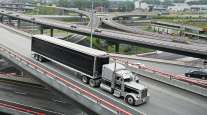ATA Completes $23 Million Renovation of Capitol Hill Office for Lobbying Staff
This story appears in the June 6 print edition of Transport Topics.
WASHINGTON — American Trucking Associations late last month moved its legislative affairs staff into its newly renovated and expanded office complex on Capitol Hill.
The complex, located in Washington at First Street and North Carolina Avenue S.E., underwent a $23 million makeover beginning in late 2007.
Originally three separate buildings, ATA’s space now includes two historic buildings — a townhouse and former retail space — and a new underground parking garage. The association also remodeled and expanded its 1970s-era office building by expanding into its former surface parking lot.
“We’ll be able to do a lot of events for members of Congress,” said Mary Phillips, senior vice president of legislative affairs at ATA. “And that’s really very important for ATA because helping elect members of Congress who are supportive of our industry is part of our government affairs.”
Phillips said the office provides multiple spaces for hosting events, such as fundraisers. There is a large conference room, a rooftop deck and two other large gathering rooms in the complex.
The association had relocated its legislative affairs staff into nearby rental space during the project.
ATA originally built the Capitol Hill office in the 1970s and later separately purchased the townhouse and corner retail building, said Rusty Duckworth, ATA controller.
During the 41-month renovation project, contractors excavated and built a parking garage under the historic buildings, significantly renovated all of the buildings and added features such as elevators.
However, due to historic preservation laws, ATA could not change much of the outside appearance of the two oldest buildings, except to bring them more in line with their original appearance, Duckworth said.
ATA said it plans to lease a significant portion of the building.
ATA also said the renovation was slowed because of underground water that was discovered during the garage construction, excessive deterioration of the historic buildings, lead-paint removal and unexpected material that was uncovered during excavation that had to be removed.




